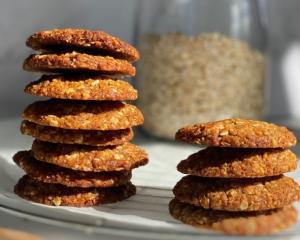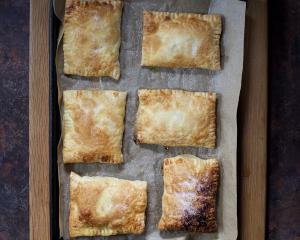
Murota, a self-taught chef, was inspired to write Japanese Home Cooking by her mother’s cooking and memories of growing up in Tokyo.
Her mission is to demystify Japanese food and make it accessible to everyone who is interested in finding out more about Japanese culture.
"This is my version of today’s Japanese cuisine."
With the birth of her daughter and Covid-19 lockdowns, her perspective on food has changed a lot and she has started to seek out more locally produced foods with less of an environmental impact.

Spending lockdown on a small French Island where access to traditional Japanese ingredients was difficult, Murota learnt to make things from scratch, discovering a joy in that process that she did not expect.
"I was pleasantly surprised — it was delicious and not as complicated as I thought it might be."
She also discovered many French-made Japanese ingredients meaning she did not have to import them from Japan.
In this book she shares her favourite 100%-homemade recipes for Japanese dishes such as ramen and sushi, as well as recipes to make miso and Japanese curry paste without using processed curry cubes.
"Cooking at home is, of course, healthier as you know exactly what is in the dish and it is more delicious."
As a vegan, she has provided many plant-based recipes in the book, but as she also cooks fish and meat for her family they are included as well — she wants to share her recipes with everyone regardless of religion or diet.
Murota has divided the book into chapters based on flour, rice, fermenting and preserving, meat, fish and tea and sweets. There is a handy resources section at the back as well.
THE BOOK
This is an extract from Japanese Home Cooking by Maori Murota, photography by Hachette Livre (Marabout). Murdoch Books RRP $55.

Have fun experimenting by adding ingredients of your choice to okonomiyaki. In Japanese, okonomi means as you like and yaki means grilled. Restaurants offer a wide choice of toppings. Feel free to invent your own version of this recipe.
Serves 4Preparation 15 minutesCooking 10 minutes per okonomiyaki
200g pointed cabbage (or white cabbage)
2 spring onions
100g peeled prawns
100g yam or potato
16 oysters
200ml water
2 eggs
200g plain flour
½ tsp salt
1 handful katsuobushi (dried bonito flakes)
4 Tbsp sunflower oil
Garnish
Okonomiyaki sauce (or tonkatsu sauce)
*Mayonnaise or soy mayonnaise
4 generous pinches katsuobushi (dried bonito flakes)
A few dill leaves (optional)
Method
Cut the cabbage into thin strips, spring onions into thin rounds and prawns in half lengthways. Grate the yam. Open the oysters and remove them from their shells.
In a bowl, mix the grated yam or potato, water and eggs. Add the flour and salt and mix. Stir in the cabbage, spring onion and katsuobushi (crumbled between your fingers). Add the prawns and oysters, then mix.
Heat a frying pan over medium heat. Pour in 1 tablespoon oil and wipe the excess with a paper towel. Pour a quarter of the batter into the hot pan. Cook for about 3 minutes.
Turn the okonomiyaki over, cover and cook for 5 minutes. Flip the okonomiyaki back and cook for another 2 to 3 minutes, uncovered. Repeat the process until all the batter is used. This will make four okonomiyaki.
Serve the okonomiyaki on individual plates with a generous amount of sauce spread on top. Add the mayonnaise. Sprinkle with some katsuobushi and decorate with a few dill leaves.
To replace the tonkatsu sauce
In a small saucepan, mix 4 Tbsp Worcestershire sauce, 2 Tbsp ketchup, 1 Tbsp mirin and ½ tsp soy sauce. Heat over low heat, stirring until the sauce thickens.
Vegan version
Replace the seafood with 150g mushrooms (oyster, shiitake, etc.) sauteed in 1 Tbsp oil and seasoned with ½ tsp salt and 1 Tbsp malted or nutritional yeast. Add an additional 100g yam.

Serves 4Preparation 15 minutesCooking time 5 minutes
4 pork cutlets, 1.5cm thick
2 pinches salt
Pepper
Oil, for frying
Tonkatsu sauce
Finely chopped cabbage or coleslaw
Lemon wedges
Crumbing
2 Tbsp plain flour
2 Tbsp plain flour + 3 Tbsp water
50g panko breadcrumbs
Method
Take the pork out of the refrigerator 30 minutes before cooking. Season each piece with salt and pepper on both sides.
Prepare three plates for crumbing: one with the flour, one with the flour and water mixed, one with the panko breadcrumbs, and arrange them in that order. Dip each piece of pork in the flour plate, then in the flour-water mixture and finally in the panko, pressing the meat lightly with your hand to make the panko stick.
In a large frying pan (the pieces of meat must not overlap; cook in two batches if needed), heat 3cm of frying oil to 180degC .
Fry the pork for 2 minutes on one side, turn over and cook for another 3 minutes, until the meat is nicely golden brown. When the bubbles around the meat become smaller, it means the pork is cooked.
Drain on paper towels and leave to rest for 3 minutes before serving with tonkatsu sauce, finely chopped cabbage or coleslaw and lemon wedges.
To replace the tonkatsu sauce
In a small saucepan, heat 4 Tbsp Worcestershire sauce, 2 Tbsp tomato sauce, 1 Tbsp mirin and ½ tsp soy sauce and mix together until the sauce thickens.
VEGAN VERSION
Replace the pork with 4 slices cauliflower, cut into 1.5cm thick slices. Steam for 3 to 4 minutes, until tender inside, but not too soft to prevent breaking. Sprinkle each side of the slices with ½ teaspoon malted or nutritional yeast, a pinch of curry powder and a pinch of salt.
Crumb and pan fry as for the pork.

Serves 4-6 (makes 40)Preparation: 1 hourResting: 30 min-1 hrCooking: 10 min
400g plain flour
1 tsp salt
200ml hot water
Pan-fried gyoza
Neutral vegetable oil
100ml water
1 tsp toasted sesame oil
For working the dough
Potato starch or cornflour
Premade filling of your choice (see below)
Method
Mix the flour and salt in a bowl. Pour in hot water and mix with chopsticks (or a fork). The dough should have the texture of a crumble topping. Once the dough has cooled slightly, knead by hand until the crumbs can be combined and form a ball.
Place it on the work surface and knead for 10 minutes until the dough is completely smooth. Make a ball. Work the folds with your fingers to smooth the ball. Turn the dough upside down with the closed side underneath. Wrap it in a damp tea towel and leave to rest for 30 minutes to 1 hour at room temperature.
Divide the ball into two logs, then cut each log into 20 small pieces. Cover the remaining dough to prevent it from drying.
On a work surface floured with starch, flatten each piece with your hand. Then hold the dough with your left hand and the rolling pin with your right hand. Roll once, turn the dough 90 degrees, roll again, turn the dough 90 degrees again, and so on until you form a nice round shape. The centre of the round must be thicker (2mm) than the edges (1mm). Flour both sides with starch and set aside under a tea towel. Repeat the process with all the pieces of dough.
Place 1 teaspoon filling in the centre of each gyoza wrapper. Wet the edge of the wrapper with your finger. To close the gyoza, fold the wrapper in half over the filling and press the middle of the two edges between your thumb and middle finger. Between the pinched middle and one side, fold to form a pleat and continue sealing the dough between your two index fingers, pinching to the end.
Repeat to seal the other side. You should get five or six pleats. Place the gyoza on a plate and press the gyoza lightly to flatten the bottom.
Pan-fried gyoza
Bring 100ml water to the boil. Oil a frying pan (with an airtight lid) with 1 tablespoon oil using a piece of paper towel and heat over medium heat. Brown the underside of the gyoza, making sure they don't touch, cooking in batches if necessary. Then pour 100ml boiling water into the pan and cover.
Cook for 7 to 8 minutes over medium-low heat. If the water evaporates before the end of cooking, add a little more. Remove the lid and drizzle 1 teaspoon toasted sesame oil over the gyoza and cook for another 1 minute until the bottom of the gyoza is nicely golden.
Boiled gyoza
Bring a large pot of water to the boil. Drop the gyoza into the water. Once the gyoza rise to the surface, leave to cook for 4 to 5 minutes. Drain.
Whichever cooking method you choose, serve the gyoza immediately.
Pork filling
Serves 4-6 (40 gyoza)Preparation 30 minSoaking 3 hours
7g dried shiitake mushrooms
150g pointed cabbage or wombok (Chinese cabbage) + ½ tsp salt
300g minced pork shoulder
1 garlic clove, grated
5g fresh ginger, peeled and finely chopped
½ small onion, finely chopped
1 Tbsp soy sauce
½ Tbsp oyster sauce
1 tsp toasted sesame oil
Pepper
Method
Rehydrate the dried shiitake mushrooms by soaking in 300ml water for 3 hours. Drain, remove the stems and finely chop the mushrooms.
Finely chop the cabbage, season with salt, mix and leave for 20 minutes to disgorge, then squeeze with hands to remove excess water.
Mix the pork with the garlic and ginger until it becomes pasty. Mix in the cabbage and onion, then add the soy sauce, oyster sauce and sesame oil. Season with pepper. Mix well and set aside in the refrigerator.
Tip
If you do not make home-made dough, make sure you buy gyoza wrappers (round and white) not wonton wrappers (square and often yellow).

Serves 4-6 (40 gyoza)Preparation 20 minsSoaking 3 hoursCooking 10 min
7g dried shiitake mushrooms
1 large zucchini (courgette) + 1 tbsp salt
1 carrot
150g pointed cabbage, curly kale or wombok (Chinese cabbage)
250g firm tofu
1 Tbsp neutral vegetable oil
1 red Asian shallot, chopped
1 garlic clove, chopped
5g fresh ginger, peeled and finely chopped
1½ Tbsp soy sauce
2 Tbsp malted or nutritional yeast
1 tsp raw sugar
1 tsp toasted sesame oil
2 tsp potato starch or cornflour
Method
Rehydrate the dried shiitake mushrooms by soaking in 300ml water for 3 hours. Drain (but keep the soaking liquid), remove the stems and finely chop the mushroom caps.
Coarsely grate the zucchini using a box grater, season with salt and leave for 15minutes to disgorge, then squeeze with hands to remove excess water.
Coarsely grate the carrot using a box grater. In a large pot of boiling water, blanch the cabbage leaves for 1 to 2 minutes, remove and drain well by squeezing between your hands, then chop.
Heat the neutral oil, shallot, garlic and ginger in a frying pan. When the aromas start to release, add the zucchini and the carrot. Saute for 2 to 3 minutes until the carrot is cooked.
Add the cabbage and shiitake mushrooms and saute for 2 minutes.
Add the soy sauce, malted yeast, sugar, sesame oil and starch.
Mix and allow to cool completely.












